Geochemistry signature, Sm-Nd and U-Pb isotopic data and age of dyke swarms in southwestern Jiroft, southern Iran
DOI:
https://doi.org/10.13133/2239-1002/17500Abstract
Numerous NW-SE trending dykes outcrop in south west of Jiroft, Southern Iran. These dykes are mainly composed of diorite, quartz diorite, gabbro-diorite, and gabbro. Plagioclases in the dyke swarm have composition ranging from An99.5Ab0.5 in cores, to An17Ab78Or5 in rims, and compositional variation with En42-49Wo39-40Fs11-18 in clinopyroxene plots across the augite field boundary. These rocks show strongly met-aluminous signatures and tholeiitic affinity. Studied rocks display LaN/LuN=0.68-2.19 and EuN/Eu*=1.63-1.92 with nearly flat heavy rare earth element (HREE). The U-Pb age dating of zircons from a dyke yielded 36.07±0.07 Ma indicating Eocene crystallization age, to an age of 783.85±1.98 Ma, indicating this dyke has zircon xenocrysts inherited. The initial 87Sr/86Sr and 143Nd/144Nd isotopic composition of studied swarm dykes are 0.705287±0.000009 and 0.512833±0.00001 respectively. Geochemical data show transitional geochemical characteristics between normal mid-ocean ridge basalt and island arc tholeiites. Geochemical and isotopic data indicate they formed by around 15% melting of a spinel-mantle source metasomatized by fluids derived from subducted oceanic slab.

Downloads
Published
Issue
Section
License
Copyright (c) 2021 Periodico di Mineralogia

This work is licensed under a Creative Commons Attribution 4.0 International License.

